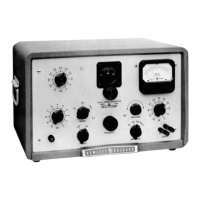which is tuned to the desired frequency by operation of the FRE-
QUENCY controls and RANGE switch. Negative feedback is applied
via variable resistor R18 and resistor R17 to the cathode of
V1.
Distortion in the oscillator output is minimized by the negative feed-
back.
The resistance network which determines the amount of negative
feedback includes lamp
R13,
which is a thermally-sensitive resist-
ance. The resistance of
lamp
R13 varies in such manner as to com-
pensate for variations in output amplitude, thus holding constant the
amplitude of oscillations, and ensuring a constant and stable output
over
a
wide frequency range. The lamp used in the Model 206Ahas
sufficient thermal inertia to ensure the desired resistance character-
istics even at low frequencies.
The output from the oscillator is passed to the selective amplifier.
3-3 SELECTIVE AMPLIFIER
The selective amplifier includes tubes V3 to
V7. The circuit is so
arranged that any incoming frequencies other than the fundamental
are filtered, amplified, and returned as
a
negative feedback to the
first stage
(V3). A practical reduction of 10 db or more in distor-
tion is obtained by this arrangement.
Tubes V3 and V4 are conventional voltage amplifiers, while V5 is
a
cathode
follower with
a
Wien bridge in its cathode circuit. The
Wien bridge is tuned to a null at the fundamental frequency so that
the fundamental is eliminated from the voltage present in the last
two stages of the amplifier. Any harmonics that may be present are
not eliminated, however, and are amplified by tube V6 which is
connected across the bridge.
Pentode V6 is
a
conventional voltage amplifier which feeds tube V7.
Pentode V7 is
a
cathode follower, the output of which is returned
to the cathode of
V3.
The circuit V7
is
in phase with the cathode
circuit of
V3, providing overall negative feedback at all frequen-
cies except that to which the bridge is balanced. Since the output
from the selective amplifier
is
taken from the top (rather than the
arms) of the bridge, the amplifier
as
a
whole exhibits a selective
characteristic with respect to the fundamental frequency.
The frequency to which the selective amplifier is tuned is deter
-
mined by the R and C values in the Wien bridge. The variable ca-
pacitors used in the bridge are so arranged that they track
withthe
variable capacitors in the oscillator circuit,
and the resistance net-
work in the bridge also is arranged to track with that of the oscil-
lator circuit. Thus adjustment of the frequency-de termining network
in the oscillator section also adjusts the
RC
network in the selective
-
amplifier circuit.
Tracking is set at the factory for the life of the
instrument.

